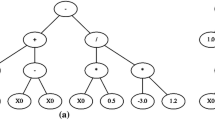Abstract
In this paper, for solving the problem of forecasting non-stationary time series, hybrid learning methods for GMDH-neural networks are proposed. Training methods combine artificial immune systems with members of the evolutionary algorithm family, in particular, gene expression programming systems. The following hybrid computational methods for the synthesis and training of GMDH-neural networks have been developed: a method in which candidate models are represented as gene expression, and training is performed by clonal selection; the method of two-phase structural-parametric synthesis, in which the structural component is formed by programming the expression of genes, and the parameterization is performed by clonal selection; a method based on cooperative-competitive processes of interaction of the elements of the immune system, in which the structure and parameters of the GMDH-neural network are represented by the entire population element-wise. Comparative experimental studies of the quality of the proposed computational methods for solving forecasting problems were carried out.
Access this chapter
Tax calculation will be finalised at checkout
Purchases are for personal use only
Similar content being viewed by others
References
Ivakhnenko AG (1971) Heuristic self-organising systems in cybernetics. Technique, Kiev, 392 p (in Russian)
Ivakhnenko AG, Ivakhnenko GA, Muller JA (1994) Selforganisation of neuronets with active neurons. Pattern Recogn Image Anal 4:177–188 (in Russian)
Anastasakis L, Mort N (2001) The development of self-organization technique in modelling: a review of the group method of data handling (GMDH). Research report no 813, Department of Automatic Control and Systems Engineering, The University of Sheffield, Sheffield
Taušer J, Buryan P (2011) Exchange rate predictions in international financial management by enhanced GMDH algorithm. Prague Econ Pap Univ Econ Prague 2011(3):232–249
Park HS, Oh SK, Ahn TC, Pedrycz WC (1999) A study on multi-layer fuzzy polynomial inference system based on extended GMDH algorithm. In: Proceedings of the 1999 IEEE international conference on fuzzy systems, FUZZ-IEEE 1999, vol 1, pp 354–359
Ivakhnenko AG, Zholnarskiy AA (1992) Estimating the coefficients of polynomials in parametric GMDH algorithms by the improved instrumental variables method. J Autom Inf Sci c/c Avtomatika 25(3):25–32 (in Russian)
Sarychev AP (1984) Stable estimation of the coefficients in multilayer GMDH algorithms. Sov Autom Control c/c Avtomatika 17(5):1–5 (in Russian)
Parker RG, Tummala MJ (1992) Identification of volterra systems with a polynomial neural network. In: Proceedings of the 1992 IEEE international conference on acoustics – speech and signal processing, ICASSP 1992, vol 4, pp 561–564
Dolenko SA, Orlov YV, Persiantsev IG (1996) Practical implementation and use of group method of data handling (GMDH): prospects and problems. In: Proceedings of the 2nd international conference on adaptive computing in engineering design and control - ACEDC 1996. PEDC, University of Plymouth, UK, pp 291–293
Onwubolu GC (2009) Hybrid self-organizing modeling systems. Springer, Berlin, pp 233–280
Moroz OV, Stepashko VS (2015) An overview of hybrid structures of GMDH-like neural networks and genetic algorithms. Inductive modeling of complex systems. K.: MNNTS IT\(\bullet \)S NAN ta MON Ukrayiny, Vyp 7, pp 173–191 (in Ukrainian)
Sharma A, Onwubolu G (2009) Hybrid particle swarm optimization and GMDH system. In: Onwubolu GC (ed) Hybrid self-organizing modeling systems, vol 211. Studies in computational intelligence. Springer, Heidelberg, pp 193–231
Onwubolu GC (2007) Design of hybrid differential evolution and group method in data handling for modeling. In: International workshop on inductive modeling, IWIM 2007, Prague, Czech, 23–26 September, pp 87–95
Ferreira C (2001) Gene expression programming: a new adaptive algorithm for solving problems. Complex Syst 13(2):87–129
Dasgupta D (1999) Artificial immune systems and their applications. Springer, Heidelberg, 306 p
De Castro LN, Timmis JC (2002) Artificial immune systems: a new computational intelligence approach. Springer, Heidelberg, 357 p
De Castro LN, Von Zuben FJ (2001) The clonal selection algorithm with engineering applications. In: Proceedings of GECCO 2000, pp 36–37
Fefelov AO, Lytvynenko VI, Bidyuk PI (2006) Cooperative algorithm for solving the problem of signal approximation, processing of signals, images and recognition of images: VIII Allukrainian mizhnar conference, 11–15 October 2006, pp 41–44 (in Ukrainian)
Artificial neural network and computational intelligence forecasting competition. http://www.neural-forecasting-competition.com/
Ardalani-Farsa M, Zolfaghari S (2010) Chaotic time series prediction with residual analysis method using hybrid Elman-NARX neural networks. Neurocomputing 2010(73):2540–2553
Shcherbakov MV, Brebels AC, Shcherbakova NL, Tyukov AP, Janovsky TA, Kamaev VA (2013) A survey of forecast error measures. World Appl Sci J 24:171–176
Author information
Authors and Affiliations
Corresponding author
Editor information
Editors and Affiliations
Rights and permissions
Copyright information
© 2020 Springer Nature Switzerland AG
About this paper
Cite this paper
Lytvynenko, V. et al. (2020). Hybrid Methods of GMDH-Neural Networks Synthesis and Training for Solving Problems of Time Series Forecasting. In: Lytvynenko, V., Babichev, S., Wójcik, W., Vynokurova, O., Vyshemyrskaya, S., Radetskaya, S. (eds) Lecture Notes in Computational Intelligence and Decision Making. ISDMCI 2019. Advances in Intelligent Systems and Computing, vol 1020. Springer, Cham. https://doi.org/10.1007/978-3-030-26474-1_36
Download citation
DOI: https://doi.org/10.1007/978-3-030-26474-1_36
Published:
Publisher Name: Springer, Cham
Print ISBN: 978-3-030-26473-4
Online ISBN: 978-3-030-26474-1
eBook Packages: Intelligent Technologies and RoboticsIntelligent Technologies and Robotics (R0)




